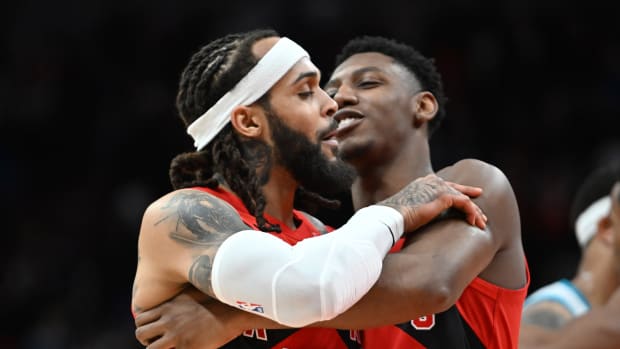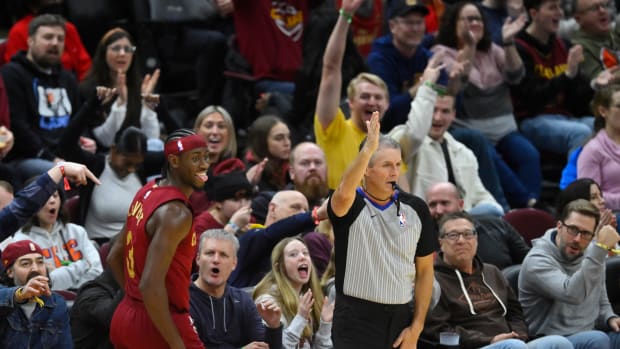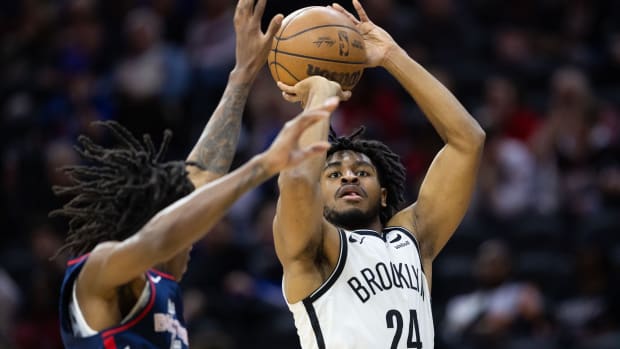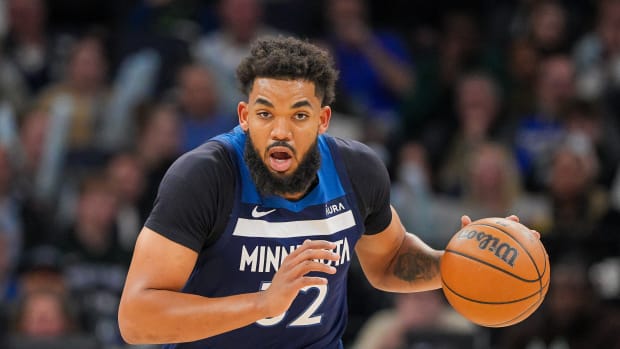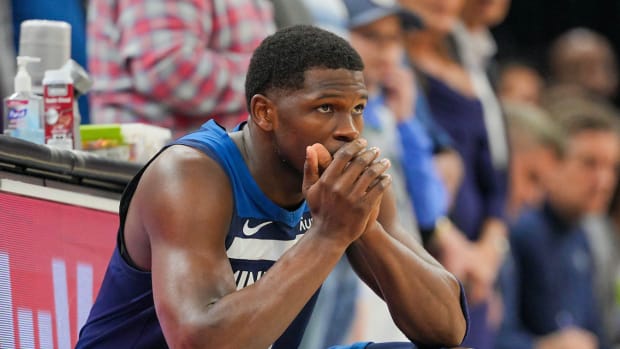Standing Tall and Talented: A stats look at Amar’e Stoudemire's career
The man who coined himself “Standing Tall and Talented” is calling it a career. After 14 seasons spent with the Suns, Knicks, Mavericks and Heat, Amar’e Stoudemire announced that he’d be retiring a Knick after signing a one-day contract with the franchise.
“Although my career has taken me to other places around the country, my heart had always remained in the Big Apple. Once a Knick, Always a Knick,” Stoudemire wrote.
This news came as a head-scratcher to Suns fans, provided Stoudemire undoubtedly had his best years in the desert. According to Arizona radio host John Gambadoro, though, the big man reportedly wanted to return to Phoenix for a final season, but was rebuffed.
• Stoudemire will play in Israel next season | Amar'e wreaked havoc in paint
If that’s the case, it makes sense that Amar’e would feel miffed by the organization who drafted him—thus the decision to retire as a Knick. But it’s also not surprising why Phoenix (if the report is true) wouldn’t open up a spot for an aging, injury-prone Stoudemire. The Suns already have a 15-man roster in place for 2016–17, and the power forward spot is now occupied by incoming lottery picks Dragan Bender and Marquese Chriss, who need court time to develop.
Regardless of the reasoning, Stoudemire’s illustrious career has come to a close. PointAfter, a sports data visualization site that’s part of Graphiq, looked back on the prep-to-pro star’s NBA tenure, beginning with a vastly successful stint with the run-and-gun Suns.
More from PointAfter (Graphiq network): All-Time Rosters for Every NBA Franchise | Ranking Every Prep-to-Pro NBA Player | The Best NBA Team Seasons in History
A Promising Start
As a raw but potential-packed prospect coming out of Cyprus Creek High School in Lake Wales, Fla., Stoudemire slipped to the No. 9 overall pick in the 2002 NBA draft. Phoenix scooped him up there, after lesser power forwards Drew Gooden, Nene and Chris Wilcox were selected.
While eight players were taken ahead of Stoudemire—including mega-hyped 7'6" center Yao Ming of China—it was the No. 9 pick who ultimately won Rookie of the Year honors for averaging 13.5 points, 8.8 rebounds and 1.1 blocks for Phoenix while playing all 82 games (71 starts).
The Hotly Contested 2002-03 Rookie of the Year Race | PointAfter
Amar’e and Yao are two of just 17 playersin league history to average at least 13 points, eight rebounds and one block while playing in all 82 games as rookies (others on that list include David Robinson, Tim Duncan, Hakeem Olajuwon and Pau Gasol).
With the help of Stoudemire, Shawn Marion and Stephon Marbury, the 2002–03 Suns reached the playoffs as the No. 8 seed in the Western Conference. They had to play the top-seeded juggernaut San Antonio Spurs in the first round.
Although Phoenix was clearly overmatched on paper, Game 1 resulted in an overtime win for the Suns thanks to a miracle three-pointer from Marbury.
The Suns eventually fell to the Spurs in six games, primarily because most of the starting unit was ice cold from the field. Marbury shot 37.5% for the series (22.7% from beyond the arc). Marion finished the series at 37.4% shooting, Anfernee “Penny” Hardaway converted 38.6% of his looks and starting center Scott Williams made just 11 of his 32 total shot attempts (34.4%).
Stoudemire, however, performed admirably in his first taste of postseason action. He shot 52.3% from the floor for the series, increasing his scoring to 14.2 points per game. As a team, the Suns shot a paltry 38.6%.
• Rockets invest in Harden, superstar equity | Biggest off-season moves
Stoudemire’s postseason performance added further clout to the belief that STAT was poised to become a great player. The 2003 playoffs were the start of something much bigger for Amar’e, but for the Suns, they first needed a new look.
After an 8–13 start the following season, the Suns fired head coach Frank Johnson and replaced him with Mike D’Antoni. Through the beginning of January, Phoenix floundered to a 12–22 mark before pulling the trigger on a blockbuster trade that sent Marbury, Hardaway and 7'2" center Cezary Trybanski to the New York Knicks for a pupu platter of players: Howard Eisley, Maciej Lampe, Antonio McDyess, Charlie Ward and Milos Vujanic, as well as a pair of first-round picks.
The desert dwellers ultimately followed a 44–38 season and a playoff berth with a disappointing 29–53 campaign—a 15-loss difference. They finished second-to-last in the conference ahead of only the lowly L.A. Clippers.
The Suns were essentially hitting the reset button by stockpiling draft picks and cap space while embracing the young core of Stoudemire, Marion and Joe Johnson. Marbury was a fan favorite in the Valley of the Sun, but moving him ultimately resulted in the greatest point guard era in Suns history.
Seven Seconds or Less
Phoenix wasted little time during its rebuild, putting together arguably (inarguably?) the best off-season in franchise history during the summer of 2004.
After a stinker of a season, the Suns brought free-agent point guard Steve Nash back to the franchise that drafted him via a four-year, $65.6 million deal. Dallas Mavericks owner Mark Cuban opted not to come close to Phoenix’s offer out of fear that Nash wouldn’t stay healthy into his 30s. About a week later, the Suns also locked up sharpshooting swingman Quentin Richardson on a six-year, $48 million contract.
Ranking NBA coaches as presidential candidates
And with that, the ‘Run-and-Gun’ Suns were assembled.
While running the pick-and-roll to poetic perfection with Nash in D’Antoni’s high-octane offense, Stoudemire scored a career-best 26 points per game.
Amar'e Stoudemire's Career Averages by Season | PointAfter
Additionally, Richardson netted 226 three-pointers, breaking a franchise record held by Dan Majerle. The Suns tied a franchise-best mark by going 62–20, matching the record set by the 1992–93 team that made the NBA Finals.
The Best Seasons in Phoenix Suns History | PointAfter
Stoudemire made the All-Star team for the first time in 2005, and was named to the All-NBA Second Team at season’s end. During his tenure with Phoenix, Stoudemire was named to five All-Star teams, earned one All-NBA First Team nod (in 2007) and three All-NBA Second Teams.
A variety of factors kept the Suns from winning a championship. The broken orbital bone suffered by Johnson in the 2005 playoffs. Cheapskate owner Robert Sarver’s decision to lowball Johnson over a measly $833,333 per season when negotiating a contract extension, then losing him in free agency soon afterward. The suspensions of Stoudemire and Boris Diaw brought on by Robert Horry’s hip check of Nash in the 2007 playoffs. Tim Donaghy. A lack of commitment and collective skill on the defensive end of the court. The departure of Marion, a two-way stud who (rightfully) felt underappreciated and overshadowed next to the Stoudemire/Nash pairing.
And, of course, Stoudemire’s own injury woes were a prevalent factor holding Phoenix back.
Damage to the cartilage in Stoudemire’s right knee required microfracture surgery after the magical 2004–05 run. He missed the first five months of the 2005–06 season, returning for just three games before shutting it down for the remainder of the year. In 2009, the big man suffered a partially detached retina in his right eye, requiring yet another surgery. He missed the final 29 regular season games of 2008–09 as well as the playoffs.
• What's Smith worth to the Cavaliers? | Golden age of power forwards
Amar'e Stoudemire: Games Played & Missed by Season | PointAfter
A combination of injuries, bad luck and a stacked Western Conference ensured that Stoudemire and the Suns never reached the NBA Finals. They did, however, go to three conference finals with the Nash/Stoudemire tandem—revolutionizing the NBA as they went.
After a six-game series loss to the Lakers in the 2010 Western Conference finals, the Stoudemire era in Arizona ended. He was sent to the New York Knicks via sign and trade that summer.
Headed to the Big Apple
By signing on with the Knicks in 2010, Stoudemire was effectively the first big name to buy in to New York’s attempt at a turnaround, endearing himself to the Knicks faithful fan base. The Knicks had missed the postseason for six straight seasons before Stoudemire came aboard.
STAT played incredibly well during his first season in NY. During the month of December, he averaged 29.8 points, 9.7 rebounds, 2.5 assists and 2.7 blocks while shooting 53.6% from the field—keeping New York in the playoff hunt in the process.
In February, the Knicks executed a blockbuster three-team deal to acquire Carmelo Anthony from the Denver Nuggets, adding another star to the fold.
Amar'e Stoudemire Q&A: Miami, art, and the Heat getting hot
Stoudemire made yet another All-Star team (his sixth) that season, as well as the All-NBA Second Team for averaging 25.3 points, 8.2 rebounds, 2.6 assists and 1.9 blocks while shooting 50.2% from the floor. But he’d never collect another major individual accolade again.
As Stoudemire battled more and more injuries, Anthony became the face of the franchise. The Knicks reached the playoffs for three consecutive seasons from 2011–2013, but only got as far as the Eastern Conference semifinals. They’ve now missed the postseason for three years running.
Amar’e was waived by the Knicks in February 2015. He signed with the Dallas Mavericks two days later, then signed with the Miami Heat the following summer. He was an afterthought in both cities, ultimately deciding to call it a career when no new contracts materialized in the summer of 2016.
Hall of Fame Case
Now that the final chapter of Stoudemire’s playing career has closed, one question remaining is whether he’ll make the Hall of Fame.
Sports writer Jack McCallum, who wrote the book “Seven Seconds or Less” that chronicles his time spent with the Suns during the 2005–06 season, said, “So far as the Hall of Fame question, I think injuries limited him a little bit too much. He never really got a team to the Finals—not that that was all his fault. […] But I don’t think the figures are quite there.”
Stoudemire ranks No. 106 on the NBA’s all-time scoring list at the time of his retirement with 15,994 career points. He’s one of 27 players to tally at least 15,000 points, 6,500 rebounds, 1,000 assists and 1,000 blocks. He averaged at least 20 points and eight rebounds for five consecutive seasons and notched at least 25 points and eight rebounds in three seasons—more than Patrick Ewing, Kevin McHale and Rick Barry (all Hall of Famers).
Comparing Stoudemire to NBA Hall of Famers | PointAfter
But is Stoudemire’s elite peak enough to make him a Hall of Famer? It’s close, but the sheer amount of injury troubles cast significant doubts.
Nevertheless, Stoudemire had a remarkable career for a guy who didn’t start playing organized basketball until he was 14 years old. And for all the bitter Suns fans who are upset by his decision to retire a Knick, Stoudemire reflected by saying, “I bleed purple and orange.”






























